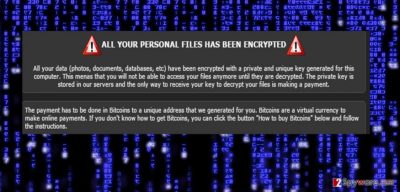Protected ransomware / virus (Improved Instructions)
Protected virus Removal Guide
What is Protected ransomware virus?
The crucial information about Protected virus
Recently published ransomware viruses are not only peculiar for their aggressiveness, but for their titles as well. This virus – Protected malware – recently joined the family of these treats which tend to ruthlessly lock out data and terrorize victims for the money in return for the information. However, few users report of retrieved information. Therefore, do not risk wasting several hundreds of dollars and, instead, find out how you can remove Protected virus. One of the ways to do it is to use the services of FortectIntego.
It is still little known about the behavior of Protected, whether it uses an email address or anonymous Tor browser. However, cyber security specialists are aware that the virus is capable of encrypting a wide range of various files. Here are some examples the virus targets to encrypt:
.srw, .pef, .ptx, .r3d, .rw2, .rwl, .raw, .raf, .orf, .nrw, .mrwref, .mef, .erf, .kdc, .dcr, .cr2, .crw, .bay, .sr2, .srf, .arw, .3fr, .dng, .jpe, .jpg, .cdr, .indd, .ai, .eps, .pdf, .pdd, .psd, .dbf, .mdf, .wb2, .rtf, .wpd, .dxg, .xf, .dwg, .pst, .accdb, .mdb, .pptm, .pptx, .ppt, .xlk, .xlsb, .xlsm, .xlsx, .xls.
For a while, you may not even suspect that highly devastating threat has settled on your computer. This is because the virus needs time to detect potentially important files and encode them using mathematically elaborate AES algorithm. Like other notorious threats, the ransomware uses public and private keys to finish the encoding of the information. After the process is finished, the virus opens up a how_to_decrypt.txt file. It also changes your desktop background to constantly remind you of the current state.

The file bears instructions how to proceed with the payment to retrieve the files. Certainly, you should not pay the money as you will only encourage the hackers to continue their criminal activity. If Protected virus has managed to encrypt highly valuable documents and personal photos, you can try PhotoRec and R-studio to recover the files. All in all, you should direct your attention to Protected removal.
When did the malware infect my computer?
It has been observed that cyber criminals prefer spreading Protected ransowmare via spam emails. Recently, there has been a noticeable increase in spam and phishing scams. Most of them deceive users by fake tax refunds or encourage opening infected attachments. To make such spam email more persuasive, they either contain the logos of existing tax or other governmental institutions. Thus, if you receive a spam which urges you to proof-check the details for tax refund and open the indicated attachment, avoid doing it. Only when you are sure that you received a legitimate email from the company, open it.
In addition, the virus may also slither into the PC using the disguise of an exploit kit. Usually, it is a trojan which is capable of escaping the attention of the security software and extract itself after settling on the computer. In order to detect and prevent it, you should install a powerful anti-spyware program. It is specifically designed for detecting such threats as trojans. It is also a reliable ransomware removal tool.
Can I efficiently remove Protected virus?
The most reliable way to exterminate the virus fully is to use the malware removal application. It will ensure that no files are left which might trigger the re-infection by Protected virus. If you want it to conduct the elimination properly, you should install the newest version or update it regularly. After that, you might concentrate on the alternatives to store your personal files. We recommend you either to keep them on the PC but perform regular back-ups or store the information in portable data storage devices: USB sticks and DVDs. Finally, if the virus has shut down your operating system and you struggle to finish Protected removal, use the guidelines, given below, to restore the access.
Getting rid of Protected virus. Follow these steps
Manual removal using Safe Mode
Important! →
Manual removal guide might be too complicated for regular computer users. It requires advanced IT knowledge to be performed correctly (if vital system files are removed or damaged, it might result in full Windows compromise), and it also might take hours to complete. Therefore, we highly advise using the automatic method provided above instead.
Step 1. Access Safe Mode with Networking
Manual malware removal should be best performed in the Safe Mode environment.
Windows 7 / Vista / XP
- Click Start > Shutdown > Restart > OK.
- When your computer becomes active, start pressing F8 button (if that does not work, try F2, F12, Del, etc. – it all depends on your motherboard model) multiple times until you see the Advanced Boot Options window.
- Select Safe Mode with Networking from the list.

Windows 10 / Windows 8
- Right-click on Start button and select Settings.

- Scroll down to pick Update & Security.

- On the left side of the window, pick Recovery.
- Now scroll down to find Advanced Startup section.
- Click Restart now.

- Select Troubleshoot.

- Go to Advanced options.

- Select Startup Settings.

- Press Restart.
- Now press 5 or click 5) Enable Safe Mode with Networking.

Step 2. Shut down suspicious processes
Windows Task Manager is a useful tool that shows all the processes running in the background. If malware is running a process, you need to shut it down:
- Press Ctrl + Shift + Esc on your keyboard to open Windows Task Manager.
- Click on More details.

- Scroll down to Background processes section, and look for anything suspicious.
- Right-click and select Open file location.

- Go back to the process, right-click and pick End Task.

- Delete the contents of the malicious folder.
Step 3. Check program Startup
- Press Ctrl + Shift + Esc on your keyboard to open Windows Task Manager.
- Go to Startup tab.
- Right-click on the suspicious program and pick Disable.

Step 4. Delete virus files
Malware-related files can be found in various places within your computer. Here are instructions that could help you find them:
- Type in Disk Cleanup in Windows search and press Enter.

- Select the drive you want to clean (C: is your main drive by default and is likely to be the one that has malicious files in).
- Scroll through the Files to delete list and select the following:
Temporary Internet Files
Downloads
Recycle Bin
Temporary files - Pick Clean up system files.

- You can also look for other malicious files hidden in the following folders (type these entries in Windows Search and press Enter):
%AppData%
%LocalAppData%
%ProgramData%
%WinDir%
After you are finished, reboot the PC in normal mode.
Remove Protected using System Restore
-
Step 1: Reboot your computer to Safe Mode with Command Prompt
Windows 7 / Vista / XP- Click Start → Shutdown → Restart → OK.
- When your computer becomes active, start pressing F8 multiple times until you see the Advanced Boot Options window.
-
Select Command Prompt from the list

Windows 10 / Windows 8- Press the Power button at the Windows login screen. Now press and hold Shift, which is on your keyboard, and click Restart..
- Now select Troubleshoot → Advanced options → Startup Settings and finally press Restart.
-
Once your computer becomes active, select Enable Safe Mode with Command Prompt in Startup Settings window.

-
Step 2: Restore your system files and settings
-
Once the Command Prompt window shows up, enter cd restore and click Enter.

-
Now type rstrui.exe and press Enter again..

-
When a new window shows up, click Next and select your restore point that is prior the infiltration of Protected. After doing that, click Next.


-
Now click Yes to start system restore.

-
Once the Command Prompt window shows up, enter cd restore and click Enter.
Finally, you should always think about the protection of crypto-ransomwares. In order to protect your computer from Protected and other ransomwares, use a reputable anti-spyware, such as FortectIntego, SpyHunter 5Combo Cleaner or Malwarebytes
How to prevent from getting ransomware
Access your website securely from any location
When you work on the domain, site, blog, or different project that requires constant management, content creation, or coding, you may need to connect to the server and content management service more often. The best solution for creating a tighter network could be a dedicated/fixed IP address.
If you make your IP address static and set to your device, you can connect to the CMS from any location and do not create any additional issues for the server or network manager that needs to monitor connections and activities. VPN software providers like Private Internet Access can help you with such settings and offer the option to control the online reputation and manage projects easily from any part of the world.
Recover files after data-affecting malware attacks
While much of the data can be accidentally deleted due to various reasons, malware is one of the main culprits that can cause loss of pictures, documents, videos, and other important files. More serious malware infections lead to significant data loss when your documents, system files, and images get encrypted. In particular, ransomware is is a type of malware that focuses on such functions, so your files become useless without an ability to access them.
Even though there is little to no possibility to recover after file-locking threats, some applications have features for data recovery in the system. In some cases, Data Recovery Pro can also help to recover at least some portion of your data after data-locking virus infection or general cyber infection.





















